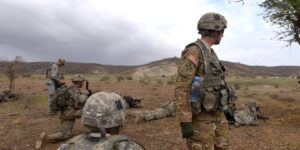
In 2006, just 1% of commandos sent overseas were deployed in the U.S. Africa Command area of operations. In 2016, 17.26% of all U.S. Special Operations forces—Navy SEALs and Green Berets included—deployed abroad were sent to Africa. As recently as 2014, that number stood at 700—a 41% increase in two years.
These numbers come to us via Nick Turse reporting in The Intercept about the massive increase in U.S. military operations on the African continent. This buildup under the Obama administration has been mostly done on the
down low, only occasionally making headlines, but it has been massive.
This is also not the only expansion of U.S. military power across the African continent in recent memory either. The American military is spending $100 million to build a new drone base in Niger.
At least 1,700 special ops soldiers are deployed across 33 African nations at any given time. The stated mission by the U.S. government is “supporting African military professionalization and capability-building efforts.” The U.S. military buildup also clearly is something of a joint project with France. In documents highlighting why they were building the new Nigerian drone base, the military noted that it “supports French regionalization.”
France has deployed roughly 3,000 troops across five of its former African colonies, allegedly as “counter-terror” forces.
France and the United States have created a vast archipelago of bases across the continent for power projection. And as we have seen, have also put thousands of boots on the ground, as well as planes, and drones in the air.
While both countries say very little about this, and cloak much of it in secrecy, it is clear a fairly major war is already being fought in Africa by the United States and the EU through African proxies as well as their own forces. If we look at where these forces are concentrated, we get an idea of the broader strategy.
In the Horn of Africa region, principally Somalia, the United States—after destabilizing the first real government there in two decades—has been waging a war where African proxy states, in exchange for money, weapons, and training, are currently conducting an occupation and war against insurgent Al Shabab. Why did the U.S. government originally destabilize the country in 2006? Principally to insure that no unreliable government was located along one of the world’s most prominent shipping lanes.
The other major concentration of soldiers is in the Sahel region, principally Mali and Niger. Again the surface level reason for them being there are Islamic insurgencies in those two countries, as well as Nigeria and Libya. These countries also happen to be rich in human and material resources, and border others with similar attributes. The rhetoric from Western nations of not allowing either a spiral of instability or a “Salafist” government is a code word for not letting the jewels slip form their hands, so to speak.
While a bit of reading between the lines is required, these motivations are fairly revealed in the U.S. government’s own documents. In the “posture review” submitted in 2016 to the Senate Armed Forces Committee, the U.S. Africa Command (AFRICOM) spoke directly to their own mission:
“Command continues to pursue the objectives of strengthening democratic institutions, spurring economic growth, trade, and investment, advancing peace and security, and promoting opportunity and development throughout Africa … Relatively small but wise investments … today offer disproportionate benefits to Africa, Europe, and the United States in the future … helping to build African institutions capable of … protecting their populations, enabling economic prosperity, and expanding the rule of law.”
Quite clearly the general emphasis is on connection nation-building (along Western “democratic” lines), stability, and economic “growth.” In other words, in strengthening the ability of resource and human-rich states to participate in the broader capitalist economic system.
It is important that we connect this to a broader strategy that harkens back to the cold war attempts to control Latin America. In the 1960s through 1980s, Latin America, strategically important to the United States, erupted in a wide variety of left-wing insurgencies, a mortal threat to the United States that feared a hemispheric shift towards socialism.
In the wake of Vietnam, boots on the ground in Latin America was not a possibility. Instead the United States built up a number of hard right authoritarian states, many led directly by the military. The U.S. nurtured ties with the security establishments lavishing them with cash, weapons, and training that allowed them to control their countries with an iron fist. In return, they made sure political forces hostile to the IMF/U.S. policies of austerity were never able to emerge, brutally drowning most of them in blood in dirty wars from El Salvador to Argentina.
The U.S. is now taking a similar strategy into resource-rich Africa. Using the ties to the military and gifts of arms and training, the U.S. is building relationships with a number of nations where the quid pro quo is clearly to act in the general broad interests that the United States would like to see, and if they have to crush an opposition demonstration or two—well the U.S. will just go ahead and look the other way.



